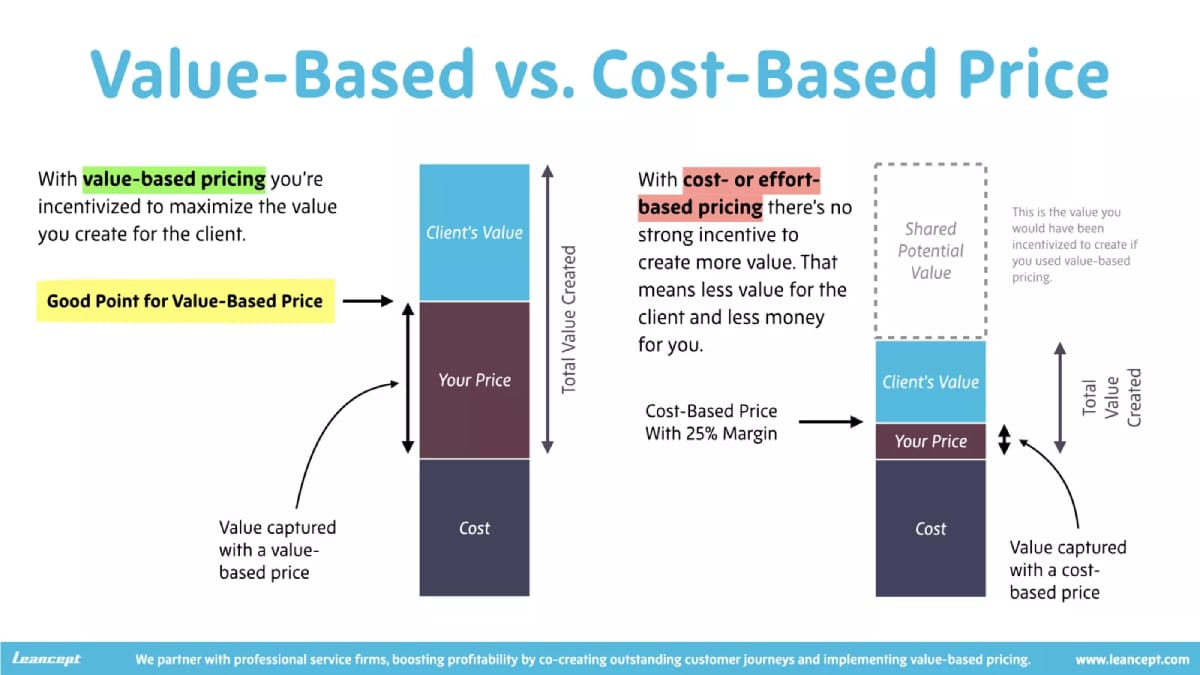A Beginner's Guide to [Value-Based Pricing]
![Cosmico - A Beginner's Guide to [Value-Based Pricing]](/content/images/size/w1200/2024/02/beginner_guide_value_based_pricing_2024_cosmico_business_tech_insights.jpg)
Value-based pricing is a strategy businesses use to price their products or services based on the perceived value to the customer, rather than the cost of production or the price of competitors. This approach requires a deep understanding of the customer's needs, preferences, and the value they attach to the product or service. Unlike cost-plus pricing, which simply adds a markup to the cost of production, or competitor-based pricing, which sets prices in reaction to competitors, value-based pricing focuses on the customer's perception of value as the key driver of pricing decisions.
Adopting a value-based pricing strategy can significantly impact a business's profitability and market position. It aligns the price with the customer's willingness to pay, potentially leading to higher profit margins and a stronger competitive advantage. Moreover, it emphasizes the importance of understanding and communicating the unique value proposition of a product or service, making it a strategic tool for businesses aiming to stand out in crowded markets.
The Benefits of Value-Based Pricing

Higher Profit Margins
By setting prices based on the value perceived by customers, businesses can often charge more than they would under cost-plus or competitor-based pricing strategies. This is because customers are willing to pay more for products or services they perceive as highly valuable or unique. As a result, businesses can achieve higher profit margins without necessarily increasing production costs.

Improved Customer Relationships
Value-based pricing also creates stronger relationships with customers. It requires businesses to engage closely with their customer base to understand their needs and how they derive value from the product or service. This customer-centric approach can lead to increased customer satisfaction and loyalty, as customers feel their needs and perceptions are being valued and addressed.
Enhanced Product Positioning and Branding
Implementing a value-based pricing strategy can enhance a product's positioning and the overall brand. By pricing products based on perceived value, companies send a strong message about the quality and benefits of their offerings. This can elevate the product's status in the market and differentiate the brand in the eyes of consumers.
Here are some examples of companies using value-based pricing:
- Rolex: Rolex, a luxury watch brand, employs a value-based pricing strategy. The high prices of Rolex watches are justified by the brand's reputation for precision, craftsmanship, and exclusivity. The perceived value of owning a Rolex goes beyond just telling time; it signifies status and a timeless sense of luxury.
- Apple: Apple is renowned for using value-based pricing for its products, particularly its iPhones. The company sets premium prices based on the perceived value of its sleek design, cutting-edge technology, and brand image. Customers are willing to pay a higher price for the perceived quality and status associated with Apple products.
- Tesla: Tesla utilizes value-based pricing for its electric vehicles. The advanced technology, long-range capabilities, and sustainable features contribute to the perceived value of Tesla cars. Despite being in a competitive market, Tesla's pricing strategy reflects the premium value associated with its electric vehicles.
- Louis Vuitton: Louis Vuitton, a luxury fashion brand, employs value-based pricing for its handbags and accessories. The brand is synonymous with quality, craftsmanship, and exclusivity. Customers are willing to pay premium prices for the perceived status and luxury associated with owning a Louis Vuitton product.
- Starbucks: Starbucks, the global coffeehouse chain, uses value-based pricing for its specialty coffee drinks. The pricing is not solely based on the cost of production, but also on the experience and perceived value of the Starbucks brand. Customers are willing to pay more for the ambiance, quality of coffee, and the overall Starbucks experience.
Aligning Price with Customer Value Perception
The core of value-based pricing is aligning the price with what customers are willing to pay based on the perceived value. This alignment ensures that the price reflects the benefits and experience the product or service provides, making it more likely that customers will see the price as justified and be willing to pay it.
Understanding Customer Value Perception

The Concept of Value in the Eyes of the Customer
Value, from a customer's perspective, is not just about the price or the quality of a product or service; it's about the overall experience and the solution it provides to their problem. It encompasses tangible benefits like functionality and performance, as well as intangible benefits such as convenience, brand reputation, and emotional satisfaction. Understanding this concept requires businesses to put themselves in their customers' shoes and see the product from their viewpoint.
Techniques for Assessing Customer Value
- Surveys and Interviews: Directly asking customers about their needs, how they use the product, and what they value most about it can yield insightful data. This qualitative approach helps in understanding the nuances of customer value perception.
- Market Research: Analyzing market trends, customer reviews of similar products, and competitive offerings can help businesses gauge what customers value in a product category.
- Customer Feedback and Usage Data: Analyzing feedback and how customers interact with the product can reveal what features or aspects they value most.
Case Studies of Successful Value Perception Alignment
One notable example is a software company that shifted from a one-size-fits-all pricing model to a value-based pricing strategy. They conducted extensive customer interviews to understand the different ways customers derived value from their software. Based on this understanding, they introduced tiered pricing plans, each tailored to different customer segments' specific needs and value perceptions. This change not only increased their revenue, but also improved customer satisfaction, as customers felt they were paying for the value they received.
Implementing Value-Based Pricing in Your Business

Step 1: Conducting Market Research
The first step in implementing a value-based pricing strategy is to conduct thorough market research. This involves identifying your target customers, understanding their needs, and how they perceive the value of your product or service. It also includes analyzing competitors to understand the market landscape and where your offering fits in.
Step 2: Segmenting Your Market Based on Value Provided
Not all customers will value your product the same way. Segmenting your market based on different value propositions allows you to tailor your pricing strategies to match each segment's needs and willingness to pay.
Step 3: Determining Your Value Proposition
Your value proposition is the unique value your product or service provides that meets the needs of your customers better than any alternative. It should be clear, concise, and compelling, highlighting the benefits and differentiators of your offering.
Step 4: Pricing Based on Perceived Value
Once you understand your customers' value perception and have defined your value proposition, you can set your prices based on the value your product or service provides. This might mean different prices for different segments or offering tiered pricing plans that reflect varying levels of value.
Step 5: Communicating the Value to Customers
Effective communication is key to value-based pricing. Your marketing and sales efforts should focus on articulating the value your product or service provides, helping customers understand why it's priced the way it is. This can involve detailed product descriptions, case studies, testimonials, and demonstrations of your product in action.
Challenges and How to Overcome Them
Implementing value-based pricing is not without its challenges. It requires a deep understanding of your customers, which can be resource-intensive to obtain. There's also the risk of misjudging value perception, leading to prices that are too high or too low. Regularly revisiting your pricing strategy, staying attuned to customer feedback, and being willing to adjust are crucial steps in overcoming these challenges.
Case Studies of Value-Based Pricing

Example 1: A Tech Company
A leading Software as a Service (SaaS) company, facing intense competition and a saturated market, decided to shift from a feature-based pricing model to a value-based pricing strategy. Initially, their pricing was based on the number of features each plan offered. However, through customer feedback and market research, they realized that their customers valued certain features more than others, specifically those that saved time and enhanced productivity.
The company conducted extensive interviews and surveys to understand which features were perceived as most valuable. They then restructured their pricing plans around these high-value features, introducing a basic plan for those who needed just the core functionalities and premium plans for users who required advanced features and integrations.
This approach allowed the company to significantly increase its average revenue per user (ARPU) as customers who derived more value from the product were willing to pay for the premium plans. Moreover, this strategy improved customer satisfaction since users felt they were paying for the value they received, not just a list of features.
Example 2: A Consumer Goods Company
A consumer goods company known for its high-quality kitchen appliances adopted a value-based pricing strategy for its new line of blenders. Instead of setting the price based solely on the cost of production plus a markup (cost-plus pricing), the company set the price based on the perceived value of the product to its customers.
The company identified that its target customers valued durability, design, and the ability to blend a wide range of ingredients smoothly. They highlighted these value propositions in their marketing campaigns, emphasizing the blender's long-term cost savings due to its durability, superior blending capabilities, and sleek design that complemented modern kitchens.
By pricing their blenders higher than the market average but below the price of the top luxury brands, the company positioned its product as a high-value option that provided the best of both worlds: premium features at a mid-range price. Sales exceeded expectations, proving that customers were willing to pay a premium for products that met their specific value criteria.
Strategies for Adapting Value-Based Pricing Over Time

Value-based pricing is not a set-it-and-forget-it strategy. Markets evolve, new competitors emerge, and customer preferences change over time. Businesses must adapt their value-based pricing strategies to stay relevant and continue providing exceptional value to their customers.
Adjusting Prices Based on Market Changes
Regular market analysis is crucial to understand shifts in customer preferences and competitive dynamics. Businesses should be prepared to adjust their prices in response to these changes to ensure that their value proposition remains compelling.
Incorporating Customer Feedback
Customer feedback is invaluable for refining value propositions and adjusting pricing strategies. Encouraging and analyzing feedback can reveal insights into how customers' perceptions of value change over time, allowing businesses to adapt their offerings and pricing models accordingly.
Innovating and Adding Value to Justify Price Changes
Innovation is key to maintaining and enhancing value in the eyes of customers. By continually improving their products or services and introducing new features that address customer needs, businesses can justify adjustments in pricing. This approach not only supports a value-based pricing strategy but also reinforces the company's commitment to delivering exceptional value.
Final Thoughts
Value-based pricing aligns a product’s price with the value it offers to customers, leading to higher profits, better customer satisfaction, and a competitive edge. This strategy requires a strong understanding of customer needs, clear communication of value, and the flexibility to adjust pricing over time.
Businesses of all sizes can benefit from value-based pricing by focusing on the value they deliver and adapting to market changes. This customer-centric approach not only drives profitability but also strengthens customer relationships and supports long-term growth.
Key Takeaways
| Key Sections | Key Takeaways |
|---|---|
| Introduction to Value-Based Pricing | • Focuses on customer-perceived value, not costs. • Requires understanding customer needs. |
| Benefits of Value-Based Pricing | • Increases profit margins and strengthens customer relationships. • Aligns prices with customer value. |
| Understanding Customer Value Perception | • Includes both tangible and intangible benefits. • Use surveys and research to gauge customer views. |
| Implementing Value-Based Pricing | • Involves market research, segmentation, and clear communication. • Adjust prices based on perceived value. |
| Case Studies | • Examples show how value-based pricing boosts revenue and satisfaction. |
| Adapting Value-Based Pricing Over Time | • Adjust prices as markets change and based on feedback. • Innovation helps maintain value and satisfaction. |
| Final Thoughts | • Focuses on delivering exceptional customer value. • Encourages continuous market engagement and innovation. |
Top Books on Value-Based Pricing
- "Value-Based Pricing: Drive Sales and Boost Your Bottom Line by Creating, Communicating and Capturing Customer Value" by Harry Macdivitt and Mike Wilkinson
- This book offers a comprehensive guide to understanding and implementing value-based pricing. It covers the essential principles of value creation, communication, and capture, providing readers with the tools they need to implement value-based pricing strategies effectively.
- "The Strategy and Tactics of Pricing: A Guide to Growing More Profitably" by Thomas T. Nagle, John Hogan, and Joseph Zale
- A classic in the field, this book presents a practical and strategic approach to pricing, emphasizing the role of pricing in achieving business objectives. It includes updated insights on value-based pricing, with practical frameworks and examples.
- "Pricing with Confidence: 10 Ways to Stop Leaving Money on the Table" by Reed K. Holden and Mark Burton
- This book focuses on overcoming common pricing challenges and avoiding the pitfalls of cost-based pricing. It provides strategies for confidently setting prices based on value, with advice on how to communicate that value to customers.
- "Implementing Value Pricing: A Radical Business Model for Professional Firms" by Ronald J. Baker
- Baker's book is a deep dive into value pricing specifically for professional services firms. It challenges traditional hourly billing models and provides a blueprint for firms looking to adopt value-based pricing, emphasizing the importance of understanding client value.
- "Priceless: The Hidden Psychology of Value" by William Poundstone
- While not exclusively about value-based pricing, this book explores the psychology behind pricing and value perception. It offers fascinating insights into how customers perceive prices and the factors influencing their willingness to pay, which are crucial for effective value-based pricing.
- "Monetizing Innovation: How Smart Companies Design the Product Around the Price" by Madhavan Ramanujam and Georg Tacke
- This book discusses how companies can innovate by designing products and services with pricing in mind from the start. It emphasizes the importance of understanding what customers value and are willing to pay for, showcasing the role of pricing in successful innovation.





